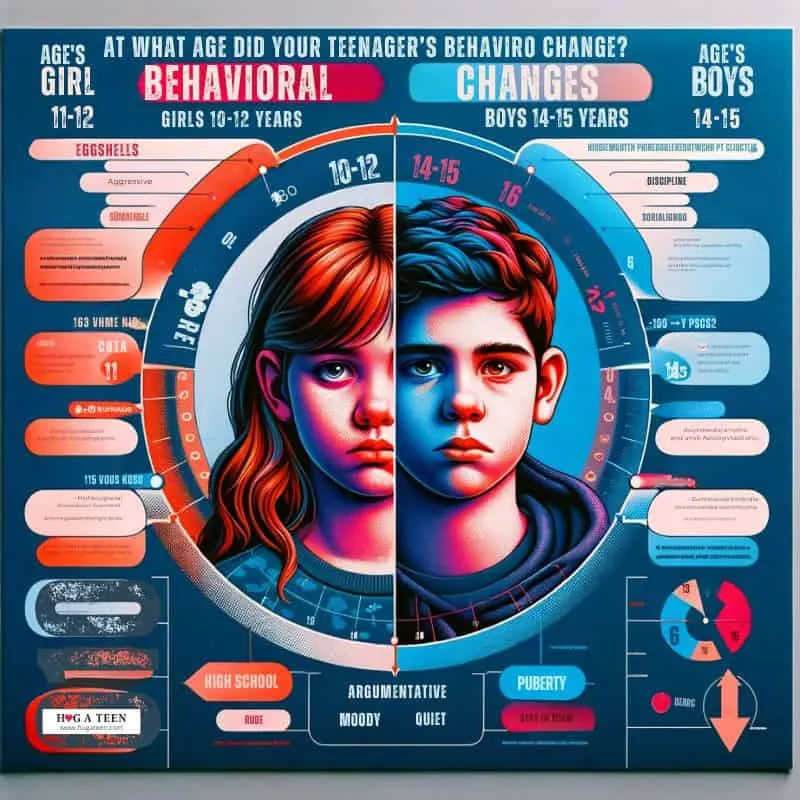Navigating the teenage years is often a rollercoaster for both parents and their children.
A recent discussion on our HugATeen Facebook group sheds light on this transitional phase, particularly at what age their children’s behavior started changing.
Parents shared their experiences and observations about when their children, who were once calm and easy-going, began to show more challenging behaviors during adolescence.
Based on the responses they provided, there appears to be a trend in the age at which behavioral changes occur during adolescence for boys and girls.
In this article, we’ll break down these observations and discuss the difference between teen behavior changes in boys and girls.
Teen Behavior Changes By Age and Gender
Around the age of twelve, children’s behaviors often become challenging and unpredictable.
They may seem to defy parents, gravitate towards peers, and make questionable choices, leaving parents unsure about how to support their development. This can lead to misunderstandings and feelings of abandonment on both sides.
However, recent advances in brain science and imaging offer insights into these teenage years. By understanding what’s happening in their developing brains, we can provide more effective guidance and support.
Research indicates that the ages between 12 and 15 are a time of significant brain changes, driven by evolutionary factors to prepare teens for adulthood. These modifications are focused on adult readiness, including reproductive, social, and economic aspects.

Age of Behavioral Changes in Girls:
- The onset of challenging behaviors in girls often starts around the ages of 10 to 12.
- This aligns with the pre-teen years and early stages of puberty.
- Several parents mentioned noticing significant changes around the ages of 13 or 14.
- There were instances of difficult behavior peaking during early teenage years (around 13-15), but some parents noted improvements as girls approached 16 or older.
Age of Behavioral Changes in Boys:
- For boys, the challenging phase often seems to begin a bit later compared to girls.
- The most commonly noted age range for the onset of difficult behaviors was around 14 to 15 years old.
- The phase of challenging behavior for boys tends to extend into the late teenage years, with some parents observing difficulties up to the age of 17 or 19.
- Some parents reported a noticeable change around 12, but this seemed less common compared to the later teenage years.
General Observations on Teen Behavior Changes:
- Both boys and girls show a range of behaviors such as moodiness, argumentativeness, and emotional changes during these years.
- The influence of external factors like school transitions and peer pressure was noted in several responses.
- A few parents pointed out the impact of lockdowns and the pandemic on their children’s behavior, indicating that external societal and environmental factors also play a significant role.

Key Insights from Parents
1. Age of Change: The onset of difficult behavior in teenagers varies, but many parents noted a significant change around the ages of 13 to 14. This age coincides with the beginning of high school in many countries, a period marked by social, emotional, and academic challenges.
Our DD changed dramatically when she turned 12. She was just starting high school, so it was a big change. Before this, she was a sweet and loving child who loved to spend time with us. Almost overnight, everything changed. She has completely withdrawn from the family and no longer communicates much. There was a sense of loss, and I miss spending time with her and who she used to be.
Hailey W.
2. Gender Differences: Some parents observed gender-based differences in the age of onset. For girls, challenging behaviors often started in the pre-teen years, around ages 10 to 12, while for boys, it tended to be slightly later, around ages 14 to 15.
3. Impact of External Factors: External factors like lockdowns during the pandemic seemed to play a role in the onset or intensity of these changes. The lack of social interaction and normal routines during lockdowns might have exacerbated the typical challenges of adolescence.
Things became difficult with our daugther when she was about 13. I think that the previous two year in lockdown had a great impact on her.
Gail S.
4. Individual Variations: Each child’s journey through adolescence is unique. Some parents reported relatively smooth teenage years, while others faced more intense challenges. Factors like personality, peer influence, and family dynamics play a significant role in shaping this experience.
5. The Role of Digital Media: The influence of online interactions and digital media was a concern for some parents. They noted that the added pressure of social media and online communities could complicate teenage behaviors and attitudes.
It seems that things are getting trickier now that we have an added online dimension!
Tony W.
6. Hope for the Future: Despite the difficulties, many parents expressed optimism. They shared experiences of their children maturing and becoming more pleasant and engaged as they approached their late teens and early twenties.
Parental Strategies and Coping Mechanisms
1. Open Communication: Maintaining open lines of communication with teenagers was highlighted as crucial. Parents who could talk openly with their children often navigated this phase more smoothly.
2. Setting Boundaries: Establishing clear boundaries while being flexible to the changing needs of teenagers is another common strategy.
3. Seeking Support: Many parents found solace in sharing their experiences and seeking advice from others going through similar challenges.
❤️ Suggested reading: Appropriate Punishment For 16 Year Old Drinking
In Summary
For girls, behavioral changes typically start in the pre-teen years (around 10-12) and can be quite pronounced around 13-14 years old.
For boys, these changes tend to start a bit later, around 14-15 years old and can extend into the later teenage years.
These trends are based on anecdotal evidence from parents and can vary widely depending on individual circumstances and external influences.
